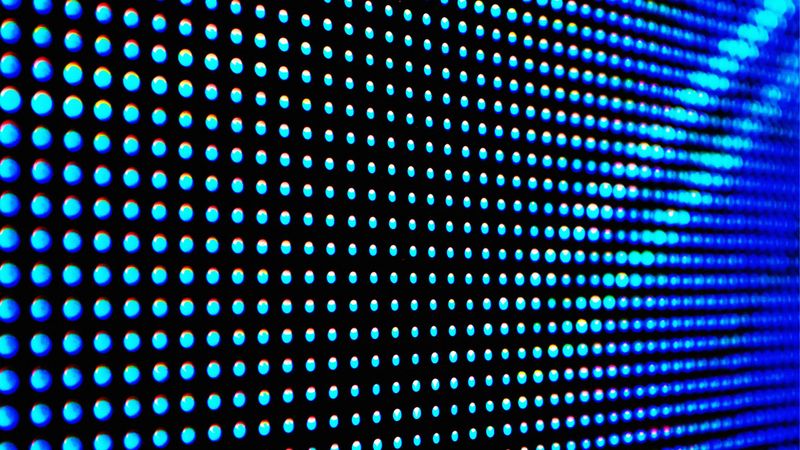How Printed Quantum Dots Are Revolutionizing Color and Efficiency in Display Technology
Quantum dot displays have replaced their dim and energy-intensive predecessors on high-end televisions, but they can also be deployed for futuristic wearable electronics and much more
Before quantum dots, displays on consumer technologies like TVs primarily fell into two categories: plasma or LCD. Plasma displays use tiny gas-filled cells that emit ultraviolet light to excite phosphors, producing vibrant colors but consuming a lot of power and suffering from a problem known as screen burn-in. LCDs (liquid crystal displays), on the other hand, use a backlight (usually CCFL, later replaced by LEDs) to shine through liquid crystals and color filters. This technology offers better efficiency than plasma but weaker contrast and color accuracy.
Since their development in the 1990s and more recent widespread adoption, quantum dots have changed the landscape of electronics displays, enhancing the color precision and brightness of LCDs. But what are quantum dots exactly? In short, they can be described as nanoscale semiconductor crystals that emit pure, tunable light when excited by energy. In QD-LCDs, a quantum dot layer converts blue LED backlight into pure red and green wavelengths, significantly expanding the color gamut compared to traditional LCDs. The result? Richer, more lifelike colors with minimal energy usage.
Newer QD-OLED technology can eliminate the need for color filters and backlights altogether, using self-emissive pixels (display pixels that generate their own light without needing a backlight) for even greater contrast and efficiency. Today, quantum dots enable displays to achieve near-Rec. 2020 color accuracy, making them ideal for high-end TVs and monitors.
Overcoming Challenges in Quantum Dot Display Production
Quantum dot displays are changing the way engineers approach electronics. However, these displays remain difficult to produce. For instance, contact printing, where a patterned stamp transfers quantum dots onto a substrate, struggles with achieving consistent dot size and spacing, and the mechanical contact can lead to defects such as smudging or uneven deposition. Additionally, it can be difficult to control the thickness and distribution of quantum dot layers at a nanoscale, which can lead to color inconsistencies.
Phase separation, which relies on self-assembly during solvent evaporation, faces its own challenges. While it offers a potential low-cost route, it can also struggle to achieve precisely arranged quantum dots with the right spacing and density. It is also sensitive to environmental factors like temperature and humidity, which makes it hard to maintain consistency across large display panels. Furthermore, phase separation can result in aggregation or clustering of quantum dots, causing color artifacts.
Challenges in quantum dot display production have led engineers and researchers to experiment with other techniques such as nanolithography, or with highly novel processes such as XTPL’s Ultra-Precise Dispensing (UPD) technology, which enables high-resolution printing of quantum dots on various substrates and topologies.
Using an ultra-precise nozzle, UPD deposits quantum dots in controlled patterns with submicron accuracy. This method allows for direct printing on flexible, rigid, or uneven surfaces, eliminating complex photolithography steps. UPD ensures uniform dot placement, improving color accuracy and efficiency in quantum dot displays while maintaining scalability for cost-effective production. One company to have successfully deployed XTPL’s technology is QustomDot, which was able to use UPD and its own custom quantum dot inks to fill microcavities.[1]
Real-World Applications and the Future of Quantum Dot Displays
Quantum dot displays have become mainstream in high-end TVs, monitors, and mobile devices. Major brands like Samsung have invested heavily in QD-OLED technology, offering brighter screens, wider color gamuts, and better energy efficiency compared to traditional LCDs. But the technology can also be deployed in other areas like AR/VR headsets and photomedical devices.[2]
XTPL’s Ultra-Precise Dispensing (UPD) technology enables high-resolution printing of quantum dots on diverse substrates, including flexible and uneven surfaces (thanks to its ability to accurately print highly viscous inks). This breakthrough opens up new possibilities in another highly interesting application of the technology: flexible or wearable electronics, where traditional manufacturing methods often struggle with adaptability and cost.
UPD allows quantum dots to be deposited with submicron precision, ensuring uniform color accuracy and high efficiency in flexible displays. Unlike photolithography, which is complex and expensive, UPD directly prints quantum dots onto materials like plastic films or stretchable substrates, making it ideal for bendable, rollable, and wearable screens. This could pave the way for next-generation smartwatches, foldable devices, and even electronic textiles—products that demand high-resolution color performance while also being lightweight and durable.
By offering a scalable and highly adaptable printing method, UPD from XTPL accelerates the development of energy-efficient, vibrant, and flexible quantum dot displays, pushing the boundaries of wearable and next-generation consumer electronics.
Resources
[1] Mohammad K, Igor N, Willem W. InP-based Quantum Dot Solutions for Efficient and Reliable Color Conversion in MicroLED Applications. InProceedings of the International Display Workshops 2023 Dec 6 (p. 918).
[2] Chen H, Yeh TH, He J, Zhang C, Abbel R, Hamblin MR, Huang Y, Lanzafame RJ, Stadler I, Celli J, Liu SW. Flexible quantum dot light‐emitting devices for targeted photomedical applications. Journal of the Society for Information Display. 2018 May;26(5):296-303.

